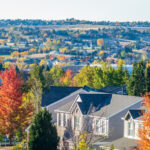Changing demographics are reigniting a hunger for community. For this and other reasons, pocket neighborhoods have a huge potentiality to increase. Pocket neighborhoods represent a pattern of housing that fosters a strong sense of community among nearby neighbors, while at the same time preserving their need for privacy. Examples can be found across the spectrum from small towns, to suburbs, to urban areas.
Now that gas prices are soaring, large homes that need lots of energy to heat and cool are losing their appeal. Homes in pocket neighborhoods may be small but are designed to feel big and airy. For example, many feature high ceilings and skylights. Parking spaces and garages are usually out of sight to encourage residents to walk home through the shared gardens. These differences help people feel like they can more easily commune with one another.
This concept is interestingly currently trending with the boomers largely in the Pacific Northwest. Why would the concept of downsizing to smaller homes with smaller yards and more communal areas be making an upswing in modern American urban developments? As a function of sustainability, a smaller footprint makes sense and the dense urban planning of a pocket neighborhood accomplishes this goal.
A more communal living space may not be for everyone, but for those who like the idea of visiting their neighbors’ porches for a cold glass of iced tea on a summer afternoon or for s’mores when it starts to chill, pocket neighborhoods could be all the rage.



